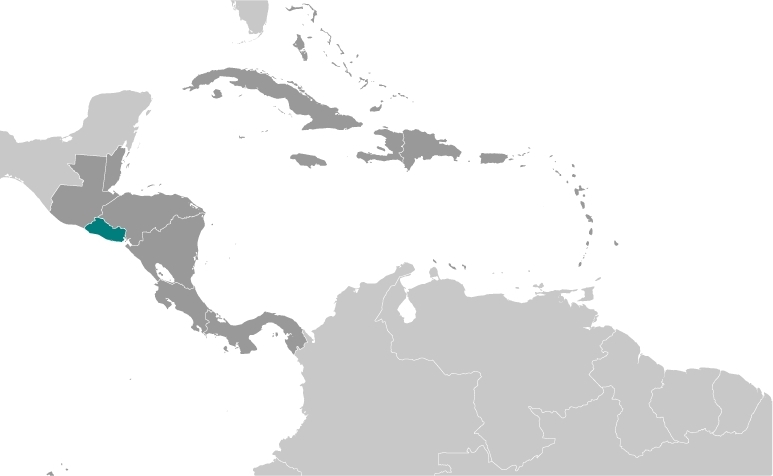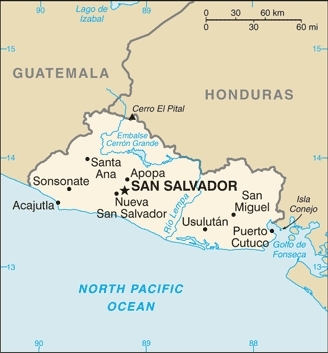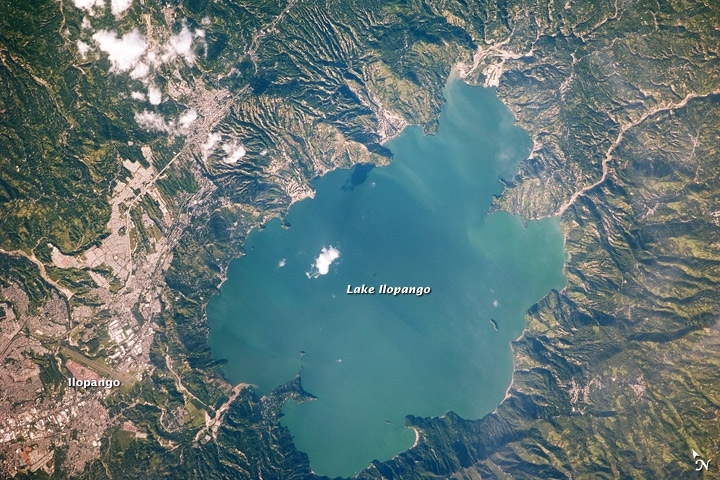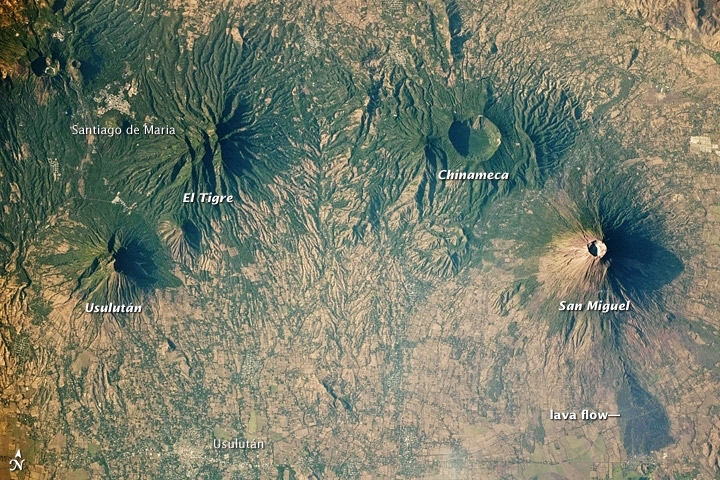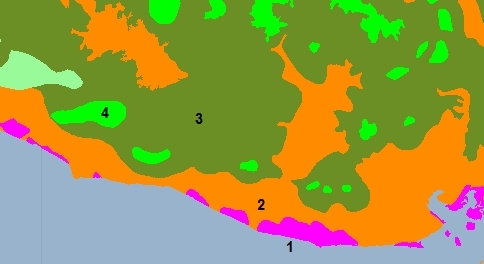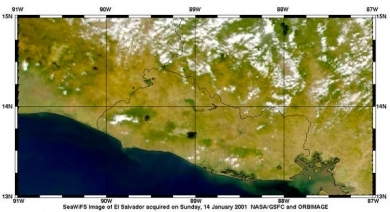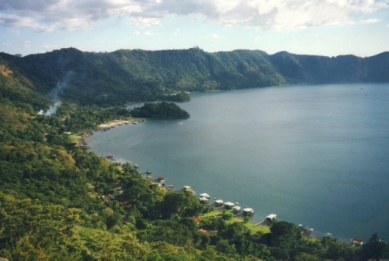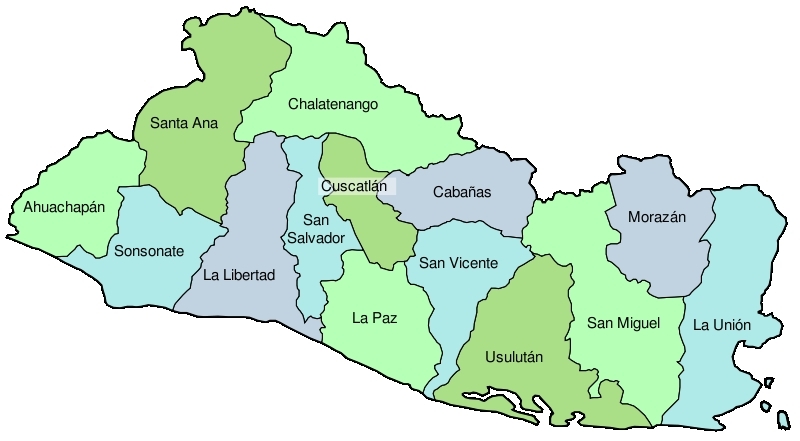El Salvador
Countries and Regions of the World Collection  El Salvador is a nation of six million people in Central American bordering Guatemala and Honduras. Its coast fronts along the Pacific Ocean.
El Salvador is a nation of six million people in Central American bordering Guatemala and Honduras. Its coast fronts along the Pacific Ocean.
It is the smallest Central American country and the only one without a coastline on Caribbean Sea.
Its main environmental issues include:
- deforestation; soil erosion;
- water pollution; and,
- contamination of soils from disposal of toxic wastes.
Known as the Land of Volcanoes, El Salvador is susceptible to frequent and sometimes destructive earthquakes and volcanic activity. It is also extremely susceptible to hurricanes.
El Salvador achieved independence from Spain in 1821 and from the Central American Federation in 1839.
A 12-year civil war, which cost about 75,000 lives, was brought to a close in 1992 when the government and leftist rebels signed a treaty that provided for military and political reforms.
Contents
Geography
Location: Central America, bordering the North Pacific Ocean, between Guatemala and Honduras
Geographic Coordinates:13 50 N, 88 55 W
Area: 21,040 sq km (20,720 sq km land and 320 sq km water)
Land Boundaries: 545 km (Guatemala 203 km, Honduras 342 km)
The International Court of Justice (ICJ) ruled on the delimitation of "bolsones" (disputed areas) along the El Salvador-Honduras boundary, in 1992, with final agreement by the parties in 2006 after an Organization of American States (OAS) survey and a further ICJ ruling in 2003. The 1992 ICJ ruling advised a tripartite resolution to a maritime boundary in the Gulf of Fonseca advocating Honduran access to the Pacific.
El Salvador continues to claim tiny Conejo Island, not identified in the ICJ decision, off Honduras in the Gulf of Fonseca
Coastline: 307 km
Maritime Claims:
territorial sea: 12 nm
contiguous zone: 24 nm
exclusive economic zone: 200 nm
Natural Hazards: Known as the Land of Volcanoes; frequent and sometimes destructive earthquakes and volcanic activity; extremely susceptible to hurricanes.
Located on the Pacific’s earthquake-prone Ring of Fire and at latitudes affected by hurricanes, El Salvador’s history has included a number of catastrophes, including the Great Hurricane of 1780 that killed 22,000 in Central America and earthquakes in 1854 and 1917 that devastated El Salvador and destroyed most of the capital city. In October 1986, an earthquake killed 1,400 and seriously damaged the nation’s infrastructure. In 1998, Hurricane Mitch killed 10,000 in the region, although El Salvador--lacking a Caribbean coast--suffered less than Honduras and Nicaragua. Major earthquakes in January and February of 2001 took another 1,000 lives and left thousands more homeless and jobless. El Salvador’s largest volcano, Santa Ana (also known by its indigenous name Ilamatepec), erupted in October 2005, spewing sulfuric gas, ash, and rock on surrounding communities and coffee plantations, killing two people and permanently displacing 5,000. Also in October 2005, Hurricane Stan unleashed heavy rains that caused flooding throughout El Salvador. In all, the flooding caused 67 deaths and more than 50,000 people were evacuated at some point during the crisis. Damages from the storm were estimated at $355.6 million.
In November 2008, rains from Tropical Storm Ida caused flooding and mudslides that killed at least 199 and left extensive property damage in the departments of Cuscatlan, La Paz, San Vicente, and San Salvador. In 2010 property evacuation operations by the authorities prevented a higher number of deaths. In June 2010, Tropical Storm Alex killed 5 people and damaged 349 homes, and in September 2010, Tropical Storm Matthew killed 3 people and damaged 141 homes. In October 2011, Tropical Depression Twelve-E and other weather systems hit El Salvador, killing 34 people and damaging 4,516 homes. The storm systems caused severe flooding, landslides, and damaged infrastructure, including 36 bridges.
Volcanism: El Salvador experiences significant volcanic activity; San Salvador (elev. 1,893 m), which last erupted in 1917, has the potential to cause major harm to the country's capital, which lies just below the volcano's slopes; San Miguel (elev. 2,130 m), which last erupted in 2002, is one of the most active volcanoes in the country; other historically active volcanoes include Conchaguita, Ilopango, Izalco, and Santa Ana.
The Central American country of El Salvador occupies a land area nearly the same size as the U.S. State of Massachusetts, and it includes numerous historically active volcanoes. This detailed astronaut photograph highlights the Ilopango Caldera that is located approximately 16 kilometers to the east of the capital city, San Salvador. Calderas are the geologic record of powerful volcanic eruptions that empty out a volcano’s magma chamber; following the eruption, the overlying volcanic structure collapses into the newly formed void, leaving a large crater-like feature (the caldera).
The last caldera-forming eruption at Ilopango occurred during the fifth century AD; it was a powerful event that produced pyroclastic flows that destroyed early Mayan cities in the region. Later volcanic activity included the formation of several lava domes within the lake-filled caldera and near the shoreline. The only historical eruption at Ilopango took place in 1879-80. This activity resulted in the formation of a lava dome in the center of Lake Ilopango. The summit of the dome forms small islets known as Islas Quemadas (visible as small white dots in the larger image). The city of Ilopango borders the lake to the west (image left), while green, vegetated hills ring the rest of the shoreline. White, patchy cumulus clouds are also visible in the image (center and upper left). Source: NASA.
The Pacific coastline of much of Central America is marked by a line of active and quiescent volcanoes known to geologists as the Central American Volcanic Arc. The volcanoes result from the upward movement of magma generated along the subduction zone between the Cocos and Caribbean tectonic plates. Frequent earthquakes also occur along the plate boundary. This astronaut photograph includes four stratovolcanoes—a type of volcano common in active subduction zones—in El Salvador, near the midpoint of the Central American Volcanic Arc.
While all of the volcanoes shown here have been active during the Holocene Epoch (from about 10,000 years ago to the present), only the 2,130-meter- (6,990-foot-) high San Miguel (also known as Chaparrastique) has been active during historical times. The most recent activity of San Miguel was a minor gas and ash emission in 2002. The stratovolcano’s steep cone shape and well-developed summit crater are evident, along with dark lava flows. Immediately to the northwest, the truncated summit of Chinameca Volcano (also known as El Pacayal) is marked by a two-kilometer- (one-mile-) wide caldera. The caldera formed when a powerful eruption emptied the volcano’s magma chamber, causing the chamber’s roof to collapse. Like its neighbor San Miguel, Chinameca’s slopes host coffee plantations.
Moving to the west, the eroded cone of El Tigre Volcano is visible. El Tigre formed during the Pleistocene Epoch (1.8 million to about 10,000 years ago), and it is likely the oldest of the stratovolcanoes in the image. Usulután Volcano is directly southwest of El Tigre. While the flanks of Usulután have been dissected by streams, the mountain still retains a summit crater that is breached on the eastern side. Several urban areas—recognizable as light gray to white regions contrasting with green vegetation and tan fallow agricultural fields—are located in the vicinity of these volcanoes, including the town of Usulután (lower left) and Santiago de Mara (upper left). Source: NASA
Terrain: Mostly mountains with narrow coastal belt and central plateau.
Climate: Tropical; rainy season (May to October); dry season (November to April); tropical on coast; temperate in uplands.
Topography of El Salvador. Source: Wikimedia Commons
Ecology and Biodiversity
All of El Salvador is included in the Mesoamerica Biodiversity Hotspot as defined by Conservation International. The Central American dry forests are an interesting ecoregion, stretching along the Pacific Coast, it corresponds to a tropical habitat that has a prolonged dry season of five to eight months and is home to important plant and animal species, as well as a significant degree of endemism. The Central American montane forests ecoregion is made up of forest patches occurring in an island-like mosaics on the isolated tops and slopes of the highest mountains of Central America, from southern Mexico into northern Nicaragua. The Central American pine-oak forests ecoregion, which is contained within several Central American countries, supports a rich assortment of conifer species. The mangrove ecosystems of this Northern dry Pacific Coast ecoregion are a truly unique ecosystem and serve as the basis for most life in the surrounding environment.
Ecoregions of El Salvador. Source: World Wildlife Fund
- Southern Mesoamerican Pacific mangroves/Northern Dry Pacific Coast mangroves (pink)
- Central American dry forests (orange)
- Central American pine-oak forests (dark green)
- Central American montane forests (light green)
|
This Sea-viewing Wide Field-of-view Sensor (SeaWiFS) view of Central America (centered on El Salvador ) is from Sunday, January 14, 2001, just a day after a large earthquake struck just offshore. The large, beige area just to the left of the lake in the center of the image (Lago de Ilopango) is probably the city of San Salvador. Source: NASA. |
| Coatepeque Caldera Lake in Santa Ana. Source: Wikimedia Commons |
People and Society
Population: 6,090,646 (July 2012 est.)
El Salvador's population numbers about 6.1 million. Almost 90% is of mixed Indian and Spanish extraction. About 1% is indigenous; very few Indians have retained their customs and traditions. The country's people are largely Roman Catholic and Protestant. Spanish is the language spoken by virtually all inhabitants. The capital city of San Salvador has about 1.7 million people; an estimated 37.5% of El Salvador's population lives in rural areas.
Ethnic groups: mestizo 90%, white 9%, Amerindian 1%
Age Structure:
0-14 years: 30.6% (male 953,842/female 905,688)
15-64 years: 63% (male 1,802,113/female 2,021,191)
65 years and over: 6.4% (male 173,363/female 215,577) (2011 est.)
Population Growth Rate: 0.303% (2012 est.)
Birthrate: 17.44 births/1,000 population (2012 est.)
Death Rate: 5.63 deaths/1,000 population (July 2012 est.)
Net migration rate: -8.78 migrant(s)/1,000 population (2012 est.)
Life Expectancy at Birth: 73.69 years
male: 70.41 years
female: 77.12 years (2012 est.)
Total Fertility Rate: 2.04 children born/woman (2012 est.)
Languages: Spanish, Nahua (among some Amerindians)
Literacy (age 15 and over can read and write):
total population: 81.1%
male: 82.8%
female: 79.6% (2007 census)
Urbanization: 64% of total population (2010) growing at an annual rate of change of 1.4% (2010-15 est.)
History
The Pipil Indians, descendants of the Aztecs, and the Pocomames and Lencas were the original inhabitants of El Salvador.
The first Salvadoran territory visited by Spaniards was Meanguera Island, located in the Gulf of Fonseca, where Spanish Admiral Andres Nino led an expedition to Central America and disembarked on May 31, 1522. In June 1524, the Spanish Captain Pedro de Alvarado started a war to conquer Cuscatlan. His cousin Diego de Alvarado established the village of San Salvador in April 1525. In 1546, Charles I of Spain granted San Salvador the title of city.
During the subsequent years, the country evolved under Spanish rule; however, toward the end of 1810 many people began to express discontent. On November 5, 1811, when Priest Jose Matias Delgado rang the bells of La Merced Church in San Salvador calling for insurrection, the people began to band together for freedom.
In 1821, El Salvador and the other Central American provinces declared their independence from Spain. When these provinces were joined with Mexico in early 1822, El Salvador resisted, insisting on autonomy for the Central American countries. In 1823, the United Provinces of Central America was formed of the five Central American states under Gen. Manuel Jose Arce. When this federation was dissolved in 1838, El Salvador became an independent republic.
El Salvador's early history as an independent state--as with others in Central America--was marked by frequent revolutions; not until the period 1900-30 was relative stability achieved. Following a deterioration in the country's democratic institutions in the 1970s a period of civil war followed from 1980-1992. More than 75,000 people are estimated to have died in the conflict. In January 1992, after prolonged negotiations, the opposing sides signed peace accords which ended the war, brought the military under civilian control, and allowed the former guerillas to form a legitimate political party and participate in elections.
Hard-line conservatives, including some members of the military, created the Nationalist Republican Alliance party (ARENA) in 1981. ARENA almost won the election in 1984 with solid private sector and rural farmer support. By 1989, ARENA had attracted the support of business groups. Multiple factors contributed to ARENA victories in the 1988 legislative and 1989 presidential elections, including allegations of corruption in the ruling Christian Democratic party which had poor relations with the private sector, and historically low prices for the nation’s main agricultural exports.
The successes of Alfredo Cristiani's 1989-94 administration in achieving a peace agreement to end the civil war and in improving the nation's economy helped ARENA--led by former San Salvador mayor Armando Calderon Sol--keep both the presidency and a working majority in the Legislative Assembly in the 1994 elections. ARENA's legislative position was weakened in the 1997 elections, but it recovered its strength, helped by divisions in the opposition, in time for another victory in the 1999 presidential race, bringing President Francisco Guillermo Flores Perez to office. Flores concentrated on modernizing the economy and strengthening bilateral relations with the United States. Under his presidency El Salvador committed itself to combating international terrorism, including sending troops to aid in the reconstruction of Iraq. El Salvador also played a key role in negotiations for the Central American Free Trade Agreement (CAFTA-DR).
Taking advantage of both public apprehension of Flores’ policies and ARENA infighting, the chief opposition party, the Farabundo Marti National Liberation Front (FMLN), was able to score a significant victory against ARENA in the March 2003 legislative and municipal elections. ARENA, left with only 29 seats in the 84-seat Legislative Assembly, was forced to court the right-wing National Conciliation Party (PCN) in order to form a majority voting bloc. However, in 2003 the PCN entered into a loose partnership with the FMLN, further limiting ARENA’s ability to maneuver in the legislature.
Despite these constraints, ARENA made a strong showing in the March 2004 presidential election, which was marked by an unprecedented 67% voter turnout. ARENA candidate Elias Antonio "Tony" Saca handily defeated the FMLN candidate and party head Shafick Handal, garnering 57.7% of the votes cast. The defeat of the FMLN’s presidential candidate rekindled an internal FMLN struggle between hardliners and more moderate members who saw the party’s 2004 defeat as a call for reform.
In January 2009 legislative and municipal elections, the incumbent ARENA party garnered 32 assembly deputies and 122 mayoralties, while the opposition FMLN won 35 legislative seats and 75 city halls (plus 21 additional mayoralties in which they participated as part of a coalition). The PCN, PDC, and CD carried 11, 5, and 1 assembly seats, respectively. The new assembly took office in May 2009. In October 2009, 12 ARENA deputies left the party to form a new movement, the Great Alliance for National Unity (GANA), and two other deputies (one each from ARENA and the PCN) left their parties to become independents. As of January 2010, the assembly was composed as follows: FMLN - 35 seats, ARENA - 19 seats, GANA - 12 seats, PCN - 10 seats, PDC - 5 seats, CD - 1 seat, independent deputies - 2 seats. In December 2009, former President Antonio Saca was expelled from ARENA for his suspected involvement in the defection of the GANA deputies.
On March 15, 2009, FMLN candidate Mauricio Funes won El Salvador’s presidential elections, defeating ARENA candidate Rodrigo Avila. Final vote totals were 51.3% for the FMLN and 48.7% for ARENA. The elections marked the first time since the 1992 peace agreement that ended the civil war that an FMLN candidate was elected president and the first left-of-center government in El Salvador’s history. President Funes was inaugurated on June 1, 2009.
Human Rights and Post-War Reforms
During the 12-year civil war, human rights violations by both the government security forces and left-wing guerillas were rampant. The accords established a Truth Commission under UN auspices to investigate the most serious cases. The commission recommended that those identified as human rights violators be removed from all government and military posts. Thereafter, the Legislative Assembly granted amnesty for political crimes committed during the war. Among those freed as a result were the Salvadoran Armed Forces (ESAF) officers convicted in the November 1989 Jesuit murders and the FMLN ex-combatants held for the 1991 murders of two U.S. servicemen. The peace accords also established the Ad Hoc Commission to evaluate the human rights record of the ESAF officer corps.
In accordance with the peace agreements, the constitution was amended to prohibit the military from playing an internal security role except under extraordinary circumstances. Demobilization of Salvadoran military forces generally proceeded on schedule throughout the process. The Treasury Police, National Guard, and National Police were abolished, and military intelligence functions were transferred to civilian control. By 1993--9 months ahead of schedule--the military had cut personnel from a war-time high of 63,000 to the level of 32,000 required by the peace accords. By 1999, ESAF strength stood at less than 15,000, including uniformed and non-uniformed personnel, consisting of personnel in the army, navy, and air force. A purge of military officers accused of human rights abuses and corruption was completed in 1993 in compliance with the Ad Hoc Commission's recommendations. The military's new doctrine, professionalism, and complete withdrawal from political and economic affairs have made it one of the most respected institutions in El Salvador.
More than 35,000 eligible beneficiaries from among the former guerrillas and soldiers who fought in the war received land under the peace accord-mandated land transfer program, which ended in January 1997. The majority of them also received agricultural credits.
Government
El Salvador is a democratic republic governed by a president and an 84-member unicameral Legislative Assembly. The president is elected by universal suffrage by absolute majority vote and serves for a 5-year term. A second round runoff is required in the event that no candidate receives more than 50% of the first round vote. Members of the assembly are elected based on the number of votes that their parties obtain in each department (circumscriptive suffrage) and serve for 3-year terms. The country has an independent judiciary and Supreme Court. Legislative and municipal elections were held in January 2009, and presidential elections were held in March 2009.
Government Type: Republic
Capital: San Salvador - 1.534 million (2009)
Administrative divisions: 14 departments (departamentos, singular - departamento); Ahuachapan, Cabanas, Chalatenango, Cuscatlan, La Libertad, La Paz, La Union, Morazan, San Miguel, San Salvador, San Vicente, Santa Ana, Sonsonate, Usulutan
Departments of El Salvador. Source:
Independence Date: 15 September 1821 (from Spain)
Legal System: civil law system with minor common law influence; judicial review of legislative acts in the Supreme Court. El Salvador has not submitted an International Court of Justice (ICJ) jurisdiction declaration; and is a non-party state to the International criminal court (ICCt).
Following the peace accords, both the Truth Commission and the Joint Group identified weaknesses in the judiciary and recommended solutions, including the replacement of all the magistrates on the Supreme Court. This recommendation was fulfilled in 1994 when an entirely new court was elected, but weaknesses remain. The process of replacing judges in the lower courts, and of strengthening the attorney generals' and public defender's offices, has moved slowly. The government continues to work in all of these areas with the help of international donors, including the United States. Amendments to the Criminal Procedure Code were passed in 2011 and will go into force in May 2012.
International Environmental Agreements
El Salvador is party to international agreements on Biodiversity, Climate Change, Climate Change-Kyoto Protocol, Desertification, Endangered Species, Hazardous Wastes, Ozone Layer Protection, and Wetlands.
Water
Total Renewable Water Resources: 25.2 cu km (2001)
Freshwater Withdrawal: 1.28 cu km/yr (25% domestic, 16% industrial, 59% agricultural)
Per Capita Freshwater Withdrawal: 186 cu m/yr (2000)
Access to improved drinking water sources: 87% of population
Access to improved sanitation facilities: 87% of population
Agriculture
Agricultural products: coffee, sugar, corn, rice, beans, oilseed, cotton, sorghum; beef, dairy products
Irrigated Land: 450 sq km (2008)
Resources
Natural Resources: hydropower, geothermal power, petroleum, arable land
Land Use:
arable land: 31.37%
permanent crops: 11.88%
other: 56.75% (2005)
Economy
The smallest country in Central America geographically, El Salvador has the third-largest economy in the region. In the last two decades, El Salvador has made considerable progress in social and economic transformation, undertaking significant social sector reforms that led to improvements in social indicators. These reforms contributed to an increase in the country’s Human Development Index--which aggregates measures of life expectancy, adult literacy and school enrollment, and income per capita--from 0.524 in 1990 to 0.674 in 2010, and a decrease in the share of households living in poverty by 23.2 percentage points, from 59.7% in 1990 and 36.5% in 2010. El Salvador ranks 105th in the Human Development Index worldwide.
Much of the improvement in El Salvador's economy is a result of the privatization of the banking system, telecommunications, public pensions, electrical distribution and some electrical generation; reduction of import duties; elimination of price controls; and improved enforcement of intellectual property rights. Capping those reforms, on January 1, 2001, the U.S. dollar became legal tender and the economy is now fully dollarized. However, El Salvador’s economy remains strongly linked to world and U.S. economic cycles. From 2000 to 2010, the Salvadoran economy averaged 2% annual economic growth, with GDP receding by 3.1% in 2009 due to the financial crisis and recovering only to 1.4% growth in 2010. El Salvador was expecting 1.4% economic growth in 2011, lower than previously anticipated. These rates of growth are decidedly below the Latin American average, and the Government of El Salvador is determined to reverse these trends by laying the groundwork for a development model built on a new cycle of investment and economic growth through the Partnership for Growth (PFG) initiative.
The Salvadoran Government has maintained fiscal discipline during post-war reconstruction and reconstruction following earthquakes in 2001 and hurricanes in 1998 and 2005. Taxes levied by the government include a value added tax (VAT) of 13%, income tax of 30%, excise taxes on alcohol and cigarettes, and import duties. The VAT accounted for about 51.7% of total tax revenues in 2011. El Salvador’s public external debt in December 2011 was about $11.9 billion, 53.2% of GDP. Performance under a 3-year Stand-By Arrangement with the International Monetary Fund remains on track.
Years of civil war, fought largely in the rural areas, had a devastating impact on agricultural production in El Salvador. The agricultural sector experienced significant recovery, buoyed in part by higher world prices for coffee and sugarcane and increased diversification into horticultural crops. Seeking to develop new growth sectors and employment opportunities, El Salvador created new export industries through fiscal incentives for free trade zones. The largest beneficiary has been the textile and apparel (maquila) sector, which directly provides approximately 80,000 jobs. Services, including retail and financial, have also shown strong employment growth, with about 63% of the total labor force now employed in the sector.
Remittances from Salvadorans working in the United States are an important source of income for many families in El Salvador. In 2011, the Central Bank estimated that remittances totaled $3.6 billion. UN Development Program (UNDP) surveys show that an estimated 21.3% of families receive remittances.
Under its export-led growth strategy, El Salvador has pursued economic integration with its Central American neighbors and negotiated trade agreements with the Dominican Republic, Chile, Mexico, Panama, Taiwan, Colombia, and the United States. In 2010, Central America signed an Association Agreement with the European Union that includes the establishment of a free trade area, which is expected to enter into force in 2012. In 2011, El Salvador signed a Partial Scope Agreement (PSA) with Cuba. The Central American countries are negotiating a free trade agreement with Canada and Peru. Exports grew by 18.4% in 2011 and imports by 19.1%. As in previous years, the large trade deficit was offset by family remittances.
In 2006, El Salvador was the first country to ratify the U.S.-Central America-Dominican Republic Free Trade Agreement (CAFTA-DR), which has bolstered the export of processed foods, sugar, and ethanol, and supported investment in the apparel sector amid increased Asian competition and the expiration of the Multi-Fiber Arrangement in 2005. From 2005 to 2011, Salvadoran exports to the U.S. increased by 27%, while imports from the U.S. increased 84%. In addition to trade benefits, CAFTA-DR provides trade capacity building, particularly in the environment and labor areas, and a framework for additional reforms on issues such as intellectual property rights, dispute resolution, and customs to improve El Salvador’s investment climate. As it has promoted an open trade and investment environment, El Salvador also has embarked on a wave of privatizations extending to telecommunications, electricity distribution, banking, and pension funds.
El Salvador has promoted an open trade and investment environment, and has embarked on a wave of privatizations extending to telecom, electricity distribution, banking, and pension funds.
The Salvadoran Government maintained fiscal discipline during post-war reconstruction and reconstruction following earthquakes in 2001 and hurricanes in 1998 and 2005.
On November 29, 2006, the Government of El Salvador and the Millennium Challenge Corporation (MCC) signed a 5-year, $461 million anti-poverty Compact to stimulate economic growth and reduce poverty in the country’s northern region. The grant seeks to improve the lives of approximately 850,000 Salvadorans through investments in education, public services, enterprise development, and transportation infrastructure. The Compact entered into force in September 2007 and will conclude in September 2012. In December 2011, the MCC Board of Directors approved El Salvador’s eligibility to develop a proposal for a second Compact for consideration.
El Salvador is one of four countries that will participate in the Partnership for Growth, which will put into practice the principles of President Barack Obama’s Policy Directive on Global Development. The Partnership for Growth represents a new way of doing business focused on using the full range of available development resources--trade, private investment, traditional financial assistance, technical assistance, private sector activity, and more--to spur higher, sustained, and more inclusive economic growth in El Salvador. To make this possible, a joint United States and El Salvador team conducted an in-depth analysis and identified the two primary constraints to economic growth in El Salvador--crime and insecurity and low productivity in trade-related activities. Having worked together to identify the key constraints, these two teams then worked together to craft joint solutions, which form the heart of the Joint Country Action Plan (JCAP). The JCAP lays out how the two countries will work together to unlock these constraints to growth by promoting a business-friendly environment, investing in people through education, and strengthening anti-crime and violence prevention efforts. The Action Plan also provides a framework for other partners--donor governments and institutions--to work with El Salvador in a similarly focused manner.
GDP: (Purchasing Power Parity): $44.78 billion (2011 est.)
GDP: (Official Exchange Rate): $22.6 billion (2011 est.)
GDP- per capita (PPP): $7,600 (2011 est.)
GDP- composition by sector:
agriculture: 11.1%
industry: 30.1%
services: 58.7% (2011 est.)
Industries: food processing, beverages, petroleum, chemicals, fertilizer, textiles, furniture, light metals
Natural Resources: hydropower, geothermal power, petroleum, arable land
Currency: US Dollar

